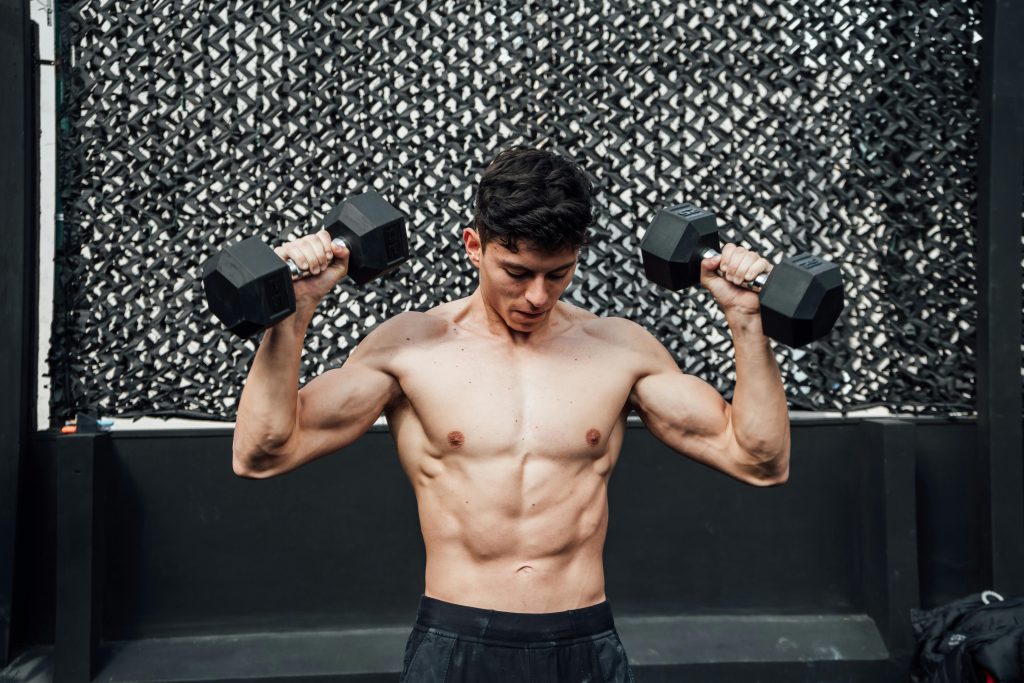Losing fat without sacrificing muscle is the holy grail of fitness goals for many men. Whether you’re trying to look leaner, improve your athletic performance, or just feel better overall, preserving muscle while burning fat is key to sustainable progress. The good news? It’s absolutely possible—if you follow the right plan.
This guide walks you through a detailed, no-nonsense strategy tailored for men who want real results. No crash diets. No endless cardio. Just proven science-backed steps that work.
- Why It’s So Important to Preserve Muscle While Losing Fat
- How to Lose Fat Without Losing Muscle: 8 Steps
- Step 1: Set the Right Caloric Deficit
- Step 2: Prioritize Protein—It’s Your Muscle Shield
- Step 3: Keep Lifting Heavy (Don’t Switch to “Light for Toning”)
- Step 4: Add Smart Cardio—But Don’t Overdo It
- Step 5: Prioritize Sleep and Recovery
- Step 6: Time Your Nutrition Around Workouts
- Step 7: Track Progress—But Not Just by the Scale
- Step 8: Be Patient—Cutting Too Fast Will Cost You Muscle
- How fast should you aim to lose fat?
- Common Mistakes to Avoid
- Supplement Smart (But Don’t Rely on Them)
- What a Sample Day Looks Like
- The Bottom Line: Stay Consistent, Stay Strong
Why It’s So Important to Preserve Muscle While Losing Fat
Before diving into the steps, let’s clear something up: losing weight doesn’t always mean losing fat. If you’re not strategic, you could end up burning through hard-earned muscle—leaving you with a “skinny fat” look and a slower metabolism.
Here’s why you should make muscle retention a top priority:
- Muscle increases metabolic rate, helping you burn more calories at rest.
- Muscle supports better body composition—less fat, more definition.
- Losing muscle means losing strength, energy, and performance.
So how do you actually do it? Let’s break it down.
How to Lose Fat Without Losing Muscle: 8 Steps
Step 1: Set the Right Caloric Deficit

How much should you eat to lose fat—not muscle?
Cutting calories too aggressively is one of the most common mistakes guys make when trying to get lean. Yes, it leads to rapid weight loss—but a lot of that “weight” can come from muscle mass, especially if you’re not eating or training correctly.
Instead of slashing calories, you need a moderate and sustainable calorie deficit. That means eating slightly less than your body needs to maintain weight—just enough to encourage fat loss without triggering muscle breakdown.
Start by calculating your TDEE (Total Daily Energy Expenditure)
TDEE is the number of calories your body burns each day, including all activity. Here’s how to estimate it:
Step 1: Multiply your body weight (in pounds) by an activity factor:
- Sedentary (little to no exercise): Body weight × 13–14
- Light activity (light workouts 1–3x/week): Body weight × 14–15
- Moderate activity (workouts 3–5x/week): Body weight × 15–16
- High activity (training 6–7x/week): Body weight × 16–17
Example: 180 lb man × 15 (moderate activity) = 2,700 calories/day (maintenance)
Step 2: Create a calorie deficit of 300–500 calories/day
- Aiming for fat loss without muscle loss, a deficit of 10–20% of your TDEE is ideal.
- Using the example above, that’s around 2,200–2,400 calories/day.
Why this range works:
- It creates fat loss at a rate of about 0.5–1 lb per week—slow enough to preserve muscle.
- It prevents drastic hormonal changes that can reduce metabolism or lead to fatigue and cravings.
Pro Tip: Use an app like MyFitnessPal, MacroFactor, or Chronometer to track your intake, make adjustments, and stay consistent.
Step 2: Prioritize Protein—It’s Your Muscle Shield
How much protein do men need during a cut?
When you’re in a calorie deficit, your body starts pulling energy from stored sources. Without enough protein, your body may break down muscle tissue for amino acids. That’s exactly what we want to avoid.
Daily Protein Goal:
- 0.8 to 1.0 grams of protein per pound of body weight
- For a 180 lb man, that’s 145–180 grams of protein per day
This range supports muscle repair, growth, and protection during fat loss.
Best High-Protein Foods for Men:
- Animal-based options:
- Chicken breast, turkey, lean beef, pork tenderloin
- Eggs and egg whites
- Fish (salmon, tuna, tilapia)
- Greek yogurt, cottage cheese
- Whey or casein protein shakes
- Plant-based options:
- Tofu, tempeh, seitan
- Lentils, black beans, chickpeas
- Edamame, quinoa, plant-based protein powders
Tips for Hitting Your Protein Target:
- Include a lean protein source with every meal and snack
- Pre-cook proteins for convenience (grilled chicken, hard-boiled eggs, etc.)
- Supplement when necessary—whey protein is an easy option post-workout or on the go
- Distribute your protein evenly—aim for 25–45g per meal
Step 3: Keep Lifting Heavy (Don’t Switch to “Light for Toning”)
Should you still lift heavy while cutting?
Yes, absolutely. Resistance training is your number one defense against muscle loss. When calories are lower, your body needs a reason to keep muscle—and that reason is heavy lifting.
Why “light weight, high reps” doesn’t work:
- Lifting light may improve muscular endurance, but it doesn’t send a strong enough signal to preserve muscle during fat loss.
- You’re also less likely to maintain strength, which is a key indicator of muscle retention.
Training Guidelines:
- Train 3–5 days per week with an emphasis on full-body or upper/lower splits.
- Focus on compound movements: squats, deadlifts, presses, pull-ups, and rows.
- Use moderate to heavy weights in the 6–12 rep range.
- Apply progressive overload: increase weight, reps, or sets over time.
- Maintain consistent intensity—don’t drastically reduce volume or effort just because you’re cutting.
Sample Weekly Split:
- Day 1: Upper Body Push (chest, shoulders, triceps)
- Day 2: Lower Body (quads, hamstrings, glutes)
- Day 3: Upper Body Pull (back, biceps)
- Day 4 (optional): Full Body or Weak Point Focus
Lifting heavy tells your body: “Hey, I still need this muscle.” So it burns fat instead.
Step 4: Add Smart Cardio—But Don’t Overdo It

Do you need cardio for fat loss?
Technically, no—but it helps. Cardio adds to your total calorie burn and improves heart health, endurance, and recovery. That said, too much cardio can interfere with strength, recovery, and muscle preservation.
Types of Cardio:
- LISS (Low-Intensity Steady-State):
- Walking, cycling, incline treadmill, light jogging
- Great for active recovery and sustainable fat burning
- HIIT (High-Intensity Interval Training):
- 20–30 sec sprints followed by 1–2 min rest
- Improves VO₂ max, burns fat efficiently in short time
Cardio Guidelines:
- 2–3 cardio sessions/week (20–30 mins each)
- Prioritize walking or biking on rest days to stay active without risking overtraining
- Schedule HIIT on separate days from heavy leg workouts to avoid recovery issues
Extra Tip:
Aim for 8,000–12,000 steps per day. Walking is low-impact, burns calories, and doesn’t interfere with strength training.
Step 5: Prioritize Sleep and Recovery
How important is sleep for fat loss and muscle retention?
Sleep isn’t just “rest”—it’s recovery. Poor sleep impacts your hormones, energy, motivation, and your body’s ability to retain muscle. Studies consistently show that sleep-deprived individuals lose more muscle and less fat during a cut.
Hormonal Impact of Poor Sleep:
- Lower testosterone: reduced ability to maintain and build muscle
- Higher cortisol: encourages fat storage, especially around the midsection
- Poor insulin sensitivity: leads to cravings, poor energy use, and less fat loss
Sleep & Recovery Checklist:
- Get 7–9 hours per night—and aim for consistency
- Set a bedtime alarm to remind yourself to wind down
- Avoid screens for 30–60 mins before bed
- Keep your room cool, quiet, and dark
- Take 1–2 rest days per week with no intense activity
Sleep is often the missing link in body recomposition. Don’t neglect it.
Step 6: Time Your Nutrition Around Workouts
Is nutrient timing important while cutting?
While total calories and protein matter most, when you eat can still improve performance and muscle retention—especially around your workouts.
Pre-Workout Nutrition (1–2 hours before):
- Purpose: Fuel your training with energy and prevent muscle breakdown
- What to eat: Carbs + protein (moderate fat)
- Example: Chicken and rice, oats with whey, banana and almond butter with protein shake
Post-Workout Nutrition (within 60 minutes):
- Purpose: Rebuild muscle, replenish glycogen, enhance recovery
- What to eat: Fast-digesting carbs + protein
- Example: Whey protein shake + banana or rice cakes
- Grilled chicken with sweet potato
Bonus Tip: Spread your total protein intake evenly throughout the day—this supports better muscle protein synthesis and prevents long gaps without amino acids.
Step 7: Track Progress—But Not Just by the Scale
Why the scale alone doesn’t tell the whole story
When you’re building or maintaining muscle while losing fat, the scale might not move much—or it may even go up slightly. That’s because muscle is denser than fat, and body composition changes don’t always show in bodyweight.
Better Ways to Track Progress:
- Weekly progress photos: Front, side, and back—same time, lighting, and pose each week
- Body measurements:
- Waist (navel and narrowest point)
- Chest
- Arms, thighs, hips
- Body fat tools:
- Smart scales and body fat calipers aren’t perfect, but they’re helpful for trend tracking over time
- Smart scales and body fat calipers aren’t perfect, but they’re helpful for trend tracking over time
- Gym performance:
- If your strength is stable or improving, your muscle is likely being preserved
- If your strength is stable or improving, your muscle is likely being preserved
Tracking multiple metrics gives you a much clearer picture of whether you’re truly losing fat and holding on to muscle.
Step 8: Be Patient—Cutting Too Fast Will Cost You Muscle
How fast should you aim to lose fat?
Men often get impatient and cut too aggressively. The key is sustainable, slow fat loss.
Target:
- 0.5 to 1 pound of fat loss per week
- Stay in a slight deficit for 8–12 weeks, then take a break or reverse diet
Why slow is better:
- Less muscle loss
- Easier to maintain strength
- Better long-term success
Common Mistakes to Avoid
- Skipping strength training and focusing only on cardio
- Cutting calories too hard, leading to muscle loss and fatigue
- Eating too little protein
- Not tracking food intake—guesswork leads to poor results
- Weighing in daily and obsessing over the scale
Supplement Smart (But Don’t Rely on Them)
Are there supplements that help with fat loss while keeping muscle?
Some supplements can support your efforts, but they won’t work without solid training, diet, and recovery.
Helpful options:
- Whey protein: Convenient way to meet protein goals
- Creatine monohydrate: Supports strength and muscle even in a deficit
- Caffeine (pre-workout or coffee): Boosts energy and fat-burning potential
- Fish oil (omega-3): Supports metabolism and recovery
Avoid “fat burner” pills that promise overnight results. Most are overpriced and underwhelming.
What a Sample Day Looks Like
Here’s an example of a day combining everything we covered:
Calories: 2,300
Protein: 180g
Workout: Strength training (pull day) + 30-minute walk
Meal 1:
- 3 eggs, 3 egg whites
- 1 cup oats with berries
- Black coffee
Meal 2 (pre-workout):
- Grilled chicken wrap with whole wheat tortilla
- Apple
Post-workout meal:
- Whey protein shake
- 1 banana
Meal 4:
- Lean ground beef
- Brown rice
- Steamed broccoli
Meal 5:
- Greek yogurt with almonds and cinnamon
Snack (optional):
- Cottage cheese or boiled eggs before bed
The Bottom Line: Stay Consistent, Stay Strong
Fat loss without muscle loss isn’t just possible—it’s sustainable if you do it right. You don’t need to starve yourself, overtrain, or follow gimmicky trends. Stick to the fundamentals: eat slightly below maintenance, prioritize protein, keep lifting heavy, add smart cardio, rest and recover, and track progress beyond the scale.
And most importantly—give it time. Muscle-preserving fat loss is a marathon, not a sprint. Stay patient, stay disciplined, and the results will come.




